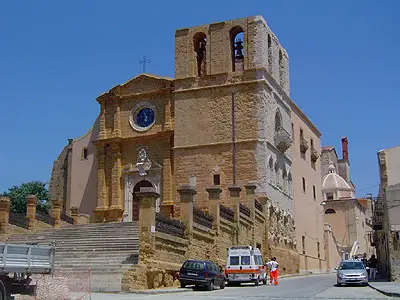AGRIGENTO
Until 1927, the City was called
Girgenti: rising up a short distance from
the Mediterranean, on a plain 326m in height, surrounded by
two rivers (San Biagio and Drago), which to the South of Agrigento,
flow into the Akragas.
The main habitation is constructed inside the l’acropoli
(acropolis) of the old city, with the Byzantium style Cathedral,
the beautiful Church of Santo Spirito (dating back to the
13th Century), the rich Museo archelogico ( archaeological
museum) , amongst which, you can find a well preserved and
valuable marble ephebe from the 5th century, an admirable
piece of local craftsmanship.
It is the native land of Empedocle, Filino and of Luigi Pirandello.
Founded by the Dori of Gela in 582BC, in a territory already
inhabited by break away factions from Siculi, Agrigento (from
the Latin Agrigentum, once upon a time also derived from the
Greek Akràgas) acquired great importance and wealth
through the tyrant Terone, collaborating with Siracusa to
contest the Carthaginian predomination of the island (an episode
during the battle of Imera in 480). Over the following years,
it was involved in a long serious of eventful occurrences:
first under the influence of Siracusa, then in 405, it was
destroyed by the Carthaginians, conquered twice by the Romans,
during the Guerre Puniche (Punic Wars), when in an attempt
to preserve its independence, it asked for the support of
the Carthaginians. Under Roman dominion, it had from the beginning
it was treated under the rules of the Civitas Decumana, following
which, it was able to acquire citizenship (43BC), still conserving
however, a notable economic importance throughout the Empire.
There was a slow decline under the Byzantines, and then without
much effort, it was conquered by the Arabs in 827; but the
Arabs destroyed it and rebuilt it higher up as a fortress.
It flourished not long after and then underwent long sieges
and pillaging by Ruggero d’Altavilla, who managed to
occupy the City in 1086 and reinstalling the Episcopal diocese,
already existent from the 6th Century but suppressed by the
Arabs. For the whole of the 13th Century, the old name of
Agrigento was transformed into the Arabian one of Girgenti,
sustained by Arabian raids: amongst the first Sicilian cities
to be sustained by Palermo during the time of the Vespri Siciliani,
during the 14th Century it suffered a feud by the Chiaramonte,
from which it was liberated in 1392 and returned to the a
free Council.
The City therefore followed the destiny of Sicily under the
Spanish and Bourbonist administration during which it suffered
a terrible famine in 1648, but then in 1763, saw the completion
of work for the port (Porto Empedocle); from then on it had
a discreet economic rise: on 15th May 1860, under the proclamation
of Garibaldi it was saved by joining the rebellious factions.
During the Second World War, it was subjected to various bombardments
and was then occupied by the Alliance on 16th July 1943.
Agrigento’s fascination derives above all from the magnificent
ruins of the Doric Temples from the Greek colonies, situated
in the celebrated Valley of the Temples,
which opens up from the foot of the City, towards the sea.
The colossal temple dedicated to Zeus Olimpio, which remains
unfinished, had, as the ruins show, enormous dimensions (117
metres in length by 54 metres in width) and was adorned with
columns which were inserted in a full wall, scattered with
giants or telamoni (male statues functioning as columns, equivalent
to the feminine caryatids), serving as a support to the trabeation:
its interior was shaped liked a cathedral with three distinct
naves. Apart from the Temple of the Concordia, one of the
best preserved in Sicily, there is also the notable Giunone
or Era Lacinia, which still has almost all its columns, and
the temples of Vulcano (Vulcan) and Ercole (Hercules), the
last being of grandiose proportions. In the temple of Dioscuri,
there has only been one corner reconstructed containing a
lot pictorial art, which has become the symbol of the City.
The Rocky Sanctury of Demetra and Persefone is also of notable
interest.
Recent digs around the old monastery of San Nicola have brought
to light the remains of the Ellenistic-Roman quarters.
There is also the Oratorio of Falaride dating back instead
to the Roman era.
In 1967 the National Archaeological Museum was established
in the centre of the Valley of the Temples.
|
